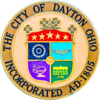Dayton, Ohio | |
|---|---|
|
| |
| Nickname(s): The Gem City, Birthplace of Aviation | |
 Interactive map of Dayton | |
| Coordinates: 39°45′34″N 84°11′30″W / 39.75944°N 84.19167°W | |
| Country | United States |
| State | Ohio |
| County | Montgomery |
| Founded | 1796 |
| 1841 (city) | |
| Named for | Jonathan Dayton |
| Government | |
| • Mayor | Jeffrey J. Mims Jr. (D) |
| Area | |
• City | 56.96 sq mi (147.52 km2) |
| • Land | 55.81 sq mi (144.54 km2) |
| • Water | 1.15 sq mi (2.99 km2) |
| Elevation | 742 ft (226 m) |
| Population (2020) | |
• City | 137,644 |
• Estimate (2023)[3] | 135,512 |
| • Density | 2,466.47/sq mi (952.31/km2) |
| • Urban | 674,046 (US: 64th) |
| • Urban density | 2,107.1/sq mi (813.6/km2) |
| • Metro | 814,049 (US: 73rd) |
| Time zone | UTC−5 (EST) |
| • Summer (DST) | UTC−4 (EDT) |
| ZIP Codes | ZIP codes[4] |
| Area codes | 937, 326 |
| FIPS code | 39113 |
| GNIS feature ID | 1086167[2] |
| Website | daytonohio.gov |
Dayton (/ˈdeɪtən/ ) is a city in Montgomery and Greene counties in the U.S. state of Ohio.[5][6] As of the 2020 census, the city proper had a population of 137,644, making it the sixth-most populous city in Ohio. It anchors the state's fourth-largest metropolitan area, the Dayton metropolitan area, which had 814,049 residents.[7] Dayton is located within Ohio's Miami Valley region, 50 miles (80 km) north of Cincinnati and 60 miles (97 km) west of Columbus. It is the county seat of Montgomery County.
Dayton was founded in 1796 along the Great Miami River and named after Jonathan Dayton, a Founding Father who owned a significant amount of land in the area.[8] It grew in the 19th century as a canal town and was home to many patents and inventors, most notably the Wright brothers, who developed the first successful motor-operated airplane.[9][10] It later developed an industrialized economy and was home to the Dayton Project, a branch of the larger Manhattan Project, to develop polonium triggers used in early atomic bombs. With the decline of heavy manufacturing in the late 20th century, Dayton's businesses have diversified into a service economy.
Ohio's borders are within 500 miles (800 km) of roughly 60 percent of the country's population and manufacturing infrastructure, making Dayton a logistics hub.[11][12] The city is home to Wright-Patterson Air Force Base, a significant contributor to research and development in the industrial, aeronautical, and astronautical engineering fields. Along with defense and aerospace, healthcare accounts for much of the Dayton area's economy.[13][14] Significant institutions in Dayton include the Air Force Institute of Technology, Carillon Historical Park, Dayton Art Institute, Dayton Performing Arts Alliance, National Museum of the United States Air Force, and University of Dayton.
- ^ "ArcGIS REST Services Directory". United States Census Bureau. Retrieved September 20, 2022.
- ^ a b U.S. Geological Survey Geographic Names Information System: Dayton, Ohio
- ^ "Annual Estimates of the Resident Population for Incorporated Places in Ohio: April 1, 2020 to July 1, 2023". United States Census Bureau. Retrieved May 16, 2024.
- ^ "Zip Code Lookup". USPS. Archived from the original on November 4, 2010. Retrieved December 2, 2014.
- ^ "Find a County". National Association of Counties. Archived from the original on May 31, 2011. Retrieved June 7, 2011.[dead link]
- ^ "Dayton Annexed Land to Stop Merger". Dayton Daily News. May 11, 2016. Archived from the original on October 17, 2016. Retrieved May 11, 2016.
- ^ "2020 Population and Housing State Data". United States Census Bureau, Population Division. May 18, 2023. Retrieved July 1, 2023.
- ^ Cite error: The named reference
Brief History of Daytonwas invoked but never defined (see the help page). - ^ "Dayton Inventions". City of Dayton. Archived from the original on September 27, 2011. Retrieved September 3, 2011.
- ^ "Dayton Aviation History". Ohio History Central. Archived from the original on August 28, 2008. Retrieved July 4, 2009.
- ^ Doug Page,"Dayton Region a Crucial Hub for Supply Chain Management", Dayton Daily News, December 21, 2009.
- ^ "Rep. Michael Turner, congressional delegation, say a shuttle in Ohio would be within a day's drive for 60 percent of Americans". PolitiFact.com. April 14, 2011. Retrieved December 13, 2011.
- ^ "Dayton area hospitals". Greater Dayton Area Hospital Association. May 25, 2009. Archived from the original on December 19, 2006.
- ^ "Economic Impact". Dayton Daily News. July 20, 2009.









